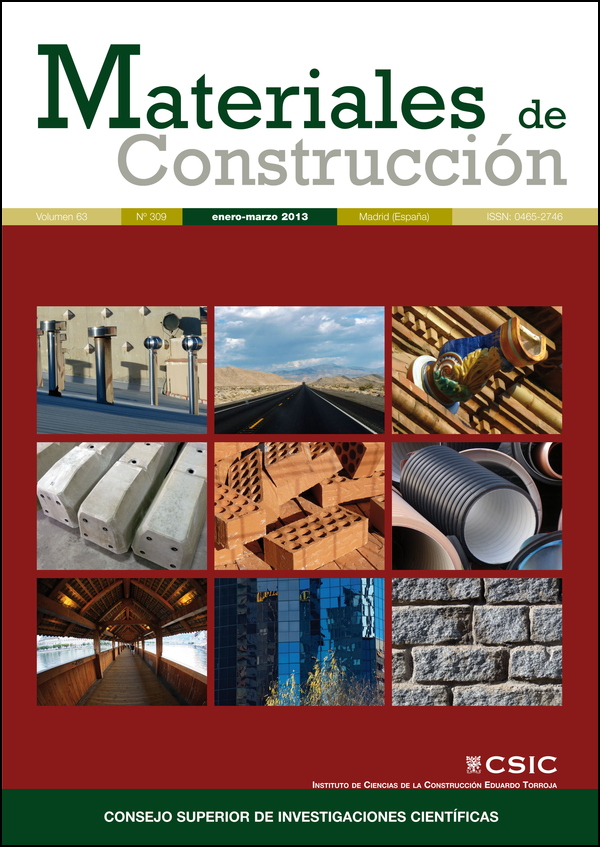Life Cycle Assessment for ecodesign of ecological roof made with Intemper TF Ecological Water-Tank System
DOI:
https://doi.org/10.3989/mc.2012.02611Keywords:
Sustainability, Ecological roofs, Ecodesign, Energy efficiency, life Cycle Assessment (LCA)Abstract
The construction industry is one of the less sustainable activities on the planet: with a consumption of 40% of the materials entering the global economy and the generation of 40–50% of the global output of greenhouse gases. The biggest environmental impact caused by buildings is generated during their use phase due to the energy consumption for thermal conditioning. Addition of green elements to buildings is used to improve energy efficiency of buildings. In this study Life Cycle Assessment (LCA) methodology has been applied to quantify the environmental impact of the green roofs materials to analyze its environmental profile. The identification of hot spots of the system permits an ecodesign strategy that effectively reduces environmental burdens associated with roof construction, optimizing the environmental performance. The results identify the high environmental impact associated to the structure, the important contribution of the felt wick irrigation system and the extruded polystyrene thermal insulation.
Downloads
References
(1) IPCC: Cambio climático 2007: Informe de síntesis. Contribución de los Grupos de trabajo I, II y III al Cuarto Informe de evaluación del Grupo Intergubernamental de Expertos sobre el Cambio Climático. Geneva, Switzerland, (2007).
(2) United Nations Environment Programme Sustainable Building Initiative: Submission to the Ad Hoc Working Group on Long-Term Cooperative Action under the Convention (AWG-LCA), (2009).
(3) UNESCO Nota introductoria al Programa en pro de la Ciencia de la UNESCO: Marco General de Acción, (1999)
(4) Nemry, F., Uihlein, A.: Environmental Improvement Potentials of Residential Buildings (IMPRO-Building). JRC Scientific and Technical Report. European Commission, Joint Research Centre, Institute for Prospective Technological Studies, (2008).
(5) Greater London Authority. Living Roofs and Walls. Technical Report: Supporting London Plan Policy, (2008).
(6) Carter, T., Fowler, L.: “Establishing Green Roof Infrastructure Through Environmental Policy Instruments”. Environ. Manage., Vol. 42, nº 1 (2008), pp. 151-164. http://dx.doi.org/10.1007/s00267-008-9095-5 PMid:18389306
(7) Takebayashi, H., Moriyama, M.: “Surface heat budget on green roof high reflection roof for mitigation of urban heat island”. Build. Environ., Vol. 42, nº 8 (2007), pp. 2971-2979. http://dx.doi.org/10.1016/j.buildenv.2006.06.017
(8) Kumar, R., Kaushik, S.C.: “Performance evaluation of green roof and shading for thermal protection of buildings”. Build. Environ., Vol. 40, nº 11 (2005), pp. 1505-1511. http://dx.doi.org/10.1016/j.buildenv.2004.11.015
(9) Machado, M., Brito, C., Neila, F. J.: “La cubierta ecológica como material de construcción”. Inf. Constr., Vol. 52, nº 467 (2000), pp. 15-29.
(10) Neila, F. J., Bedoya, C., Acha, C., Olivieri, F., Barbero. M.: “Las cubiertas ecológicas de tercera generación: un nuevo material constructivo”. Inf. Constr., Vol. 60, nº 511 (2008), pp. 15-24.
(11) Saiz, S., Kennedy, C., Bass, B., Pressnail, K.: “Comparative Life Cycle Assessment of Standard and Green Roofs”. Environ. Sci. Technol., Vol. 40 (2006), pp. 4312-4316. http://dx.doi.org/10.1021/es0517522
(12) Macías, M., García Navarro. J.: “Metodología y herramienta VERDE para la evaluación de la sostenibilidad en edificios”. Inf. Constr., Vol. 62, nº 517 (2010), pp. 87-100.
(13) Rivela, B., Moreira, M.T., Muñoz, I., Rieradevall, J., Feijoo, G.: “Wood Waste from Ephemeral Architecture: Using Life Cycle Assessment to Identify the Best Choice”. Sci. Total Environ., Vol. 357, nº 1-3 (2006), pp. 1-11. http://dx.doi.org/10.1016/j.scitotenv.2005.04.017 PMid:15922411
(14) Norma UNE-EN ISO 14040:2006. Gestión ambiental. Análisis de ciclo de vida. Principios y marco de referencia.
(15) EN 15643-1 Sustainability of construction works - Integrated assessment of building performance. Part 1: General framework.
(16) EN 15643-2 Sustainability of construction works - Assessment of buildings - Part 2: Framework for the assessment of the environmental performance.
(17) EN 15978 Sustainability of construction works - Assessment of environmental performance of buildings - Calculation methods.
(18) Tomerius, C.: Meydan Shopping Square. A new prototype by FOA. A Metro Group Project in Istanbul. Jovis, (2007).
(19) Guinée, J.B., Gorreé, M., Heijungs, R., Huppes, G., Kleijn, R., de Koning, A., van Oers, L.A., Weneger, A., Suh, S., Udo de Haes, H.A., de Bruijn, H.; van Duin, R., Huijbregts, M.: Life cycle assessment: An operational guide to the ISO standards. Leiden, Netherlands, (2001).
(20) Norma UNE-ISO 21930:2010 Sostenibilidad en la construcción de edificios. Declaración ambiental de productos de construcción.
(21) EN 15804 Sustainability of construction works - Environmental product declarations - Product category rules.
(22) ILCD Handbook. International Reference Life Cycle Data System. General guide for Life Cycle Assessment. Detailed guidance. European Commission, Joint Research Centre, Institute for Environment and Sustainability, (2010).
(23) Hischier, R., Althaus H.J., Bauer, Chr., Doka, G., Frischknecht R., Jungbluth N., Margni M., Nemecek, T., Simons A., Spielmann M.: Documentation of changes implemented in ecoinvent Data v2.1. Final report ecoinvent data v2.1. Volume: 16. Swiss Centre for LCI, Dübendorf. CH, (2009).
Downloads
Published
How to Cite
Issue
Section
License
Copyright (c) 2013 Consejo Superior de Investigaciones Científicas (CSIC)

This work is licensed under a Creative Commons Attribution 4.0 International License.
© CSIC. Manuscripts published in both the print and online versions of this journal are the property of the Consejo Superior de Investigaciones Científicas, and quoting this source is a requirement for any partial or full reproduction.
All contents of this electronic edition, except where otherwise noted, are distributed under a Creative Commons Attribution 4.0 International (CC BY 4.0) licence. You may read here the basic information and the legal text of the licence. The indication of the CC BY 4.0 licence must be expressly stated in this way when necessary.
Self-archiving in repositories, personal webpages or similar, of any version other than the final version of the work produced by the publisher, is not allowed.
















